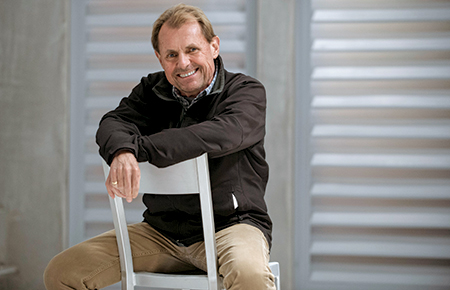Winter 2015
 The career of 1st AD Bruce Moriarty would be remarkable enough even if he’d never left his native Ontario, Canada, in the early 1980s. As a skilled stunt rider and trainer and self-described “horseman,” he had worked on two Black Stallion films and ran a company that flew thoroughbreds (including Secretariat) around the world. It proved to be perfect training for further adventures in the movie business.
The career of 1st AD Bruce Moriarty would be remarkable enough even if he’d never left his native Ontario, Canada, in the early 1980s. As a skilled stunt rider and trainer and self-described “horseman,” he had worked on two Black Stallion films and ran a company that flew thoroughbreds (including Secretariat) around the world. It proved to be perfect training for further adventures in the movie business.
Moriarty joined the Guild in 1983 and spent a number of years as a 1st AD running second units on such blockbusters as Back to the Future Part II (1989) and Part III (1990) and Backdraft (1991), well before the advent of CGI. But now as Zack Snyder’s go-to 1st AD on Man of Steel (2013) and the upcoming Batman v Superman: Dawn of Justice, he is in the middle of large-scale moviemaking in the computer age.
Working with Snyder, who was weaned on digital technology, made it easier for Moriarty to run sets on complex CGI tentpoles. “The beauty of Zack is that he only shoots with one camera, and he [storyboards] everything himself,” says Moriarty. “We stand together on a green-screen stage and Zack knows exactly what the visual effect is going to be before it’s rendered. It’s point-to-point filmmaking with no surprises.”
Yet ask Moriarty about his most memorable experience in his more than three-decade career, and he immediately harks back to Robert Zemeckis’ Forrest Gump (1994). “We knew we were making something special,” says Moriarty. He cites the film’s famous peace rally scene at the Lincoln Memorial Reflecting Pool in Washington as a highlight. “I only had 1,500 extras and we ended up making [it look like] 3,000,” he recalls. “We did it all in-camera using repeatable dollies and nodal heads [for panoramic time-lapse photography]. And shooting the scene of Forrest at Jenny’s grave was so gratifying—it was a simpler time for filmmaking and it stays with you.”
Shooting Casino Royale (2006) at Pinewood Studios was anything but simple, requiring more stage space than anything Moriarty had ever worked on before. “The final action sequence underwater, as the house is sinking on the Venice canal, was so massive,” he says. “We shot it all live action, with three huge hydraulic sets. I had [actress] Eva Green buddy breathing at the bottom of a tank in an elevator shaft cage. So it was all for real.”
Real or CGI, Moriarty says “the biggest challenge on a movie set is trying to keep people motivated to do a day’s work that isn’t easy to do. It’s not all that different from where I started [on horse farms in Canada], if you think about it.”
Continuing with the equine comparison, Moriarty says: “Just like a horse who can sense an inexperienced rider, film crews know when the path to delivering a director’s vision is less than reasonable. My job is to find that balance, and keep both crew and director happy for the good of the project.”